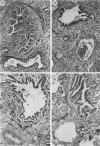Abstract
18 patients with idiopathic pulmonary fibrosis were studied to determine if they had morphologic evidence of small airways disease and if physiologic testing could predict morphologic findings. In the presence of normal airway function by standard physiologic studies (forced expiratory volume in 1 s/forced vital capacity and airway resistance by plethysmography), dynamic compliance, maximum expiratory flow-volume curves, and maximum flowstatic recoil curves were measured to detect physiologic alterations consistent with small airways abnormalities. These physiologic data were then compared with estimates of small airways diameter made in lung biopsy specimens.
94% (17 of 18) of the patients had peribronchiolar fibrosis or peribronchiolar inflammation or bronchiolitis. 67% (12 of 18) had an overall estimate of small airways diameter of “narrowed,” whereas 33% (6 of 18) had airways that overall were “not narrowed.” 59% (10 of 17) had frequency-dependent dynamic compliance, 50% (9 of 18) had abnormal maximum expiratory flow-volume curves, and 39% (7 of 18) had abnormal maximum flow-static recoil curves. Comparisons between morphologic and physiologic data revealed a significant correlation between the results of dynamic compliance and the overall estimate of small airways diameter (P = 0.001), and the results of maximum flow-volume curves and the overall estimate of small airways diameter (P = 0.009); there was no significant correlation between the results of maximum flow-static recoil curves and the overall estimate of small airways diameter (P = 0.1).
The results of this study suggest that: (a) idiopathic pulmonary fibrosis is a disease of small airways as well as alveoli; (b) dynamic compliance and the maximum expiratory flow-volume curve can predict the overall status of small airways diameter in idiopathic pulmonary fibrosis; and (c) whereas the maximum flowstatic recoil curve predicts the overall estimate of small airways diameter in most patients with this disease, it is the least sensitive of these three monitors of small airways.
Full text
PDF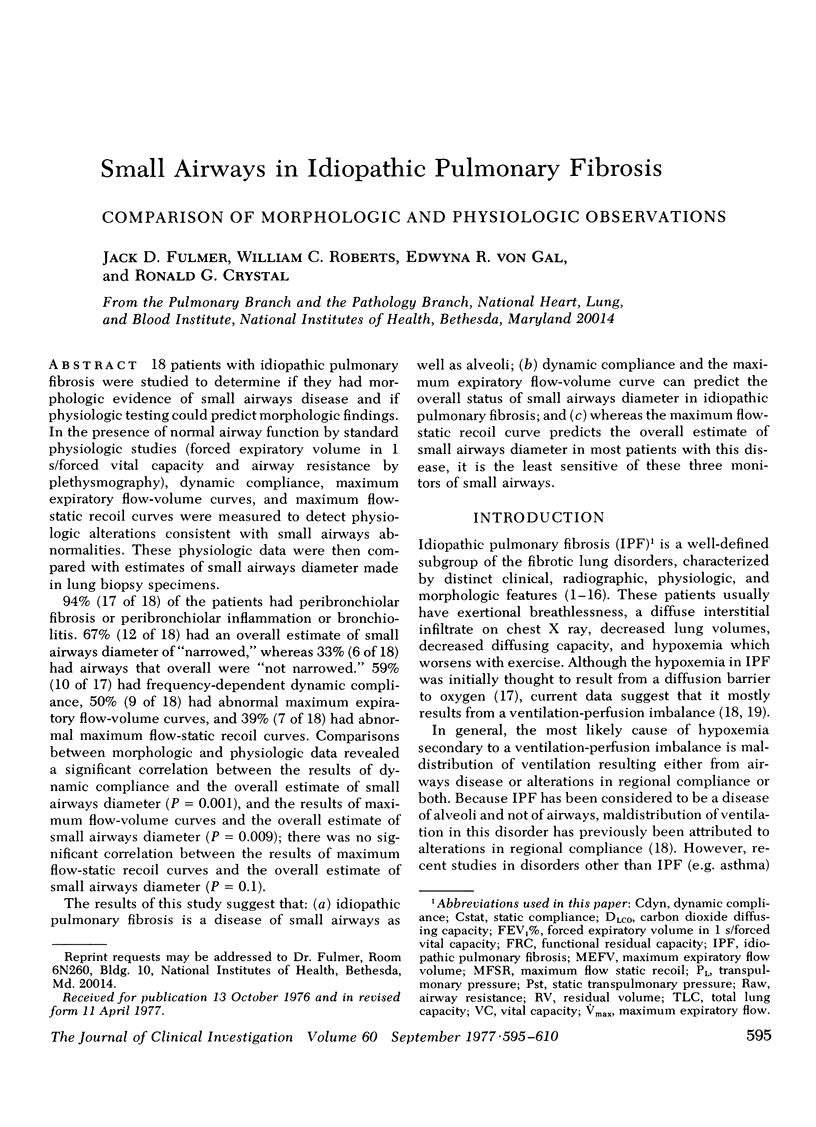

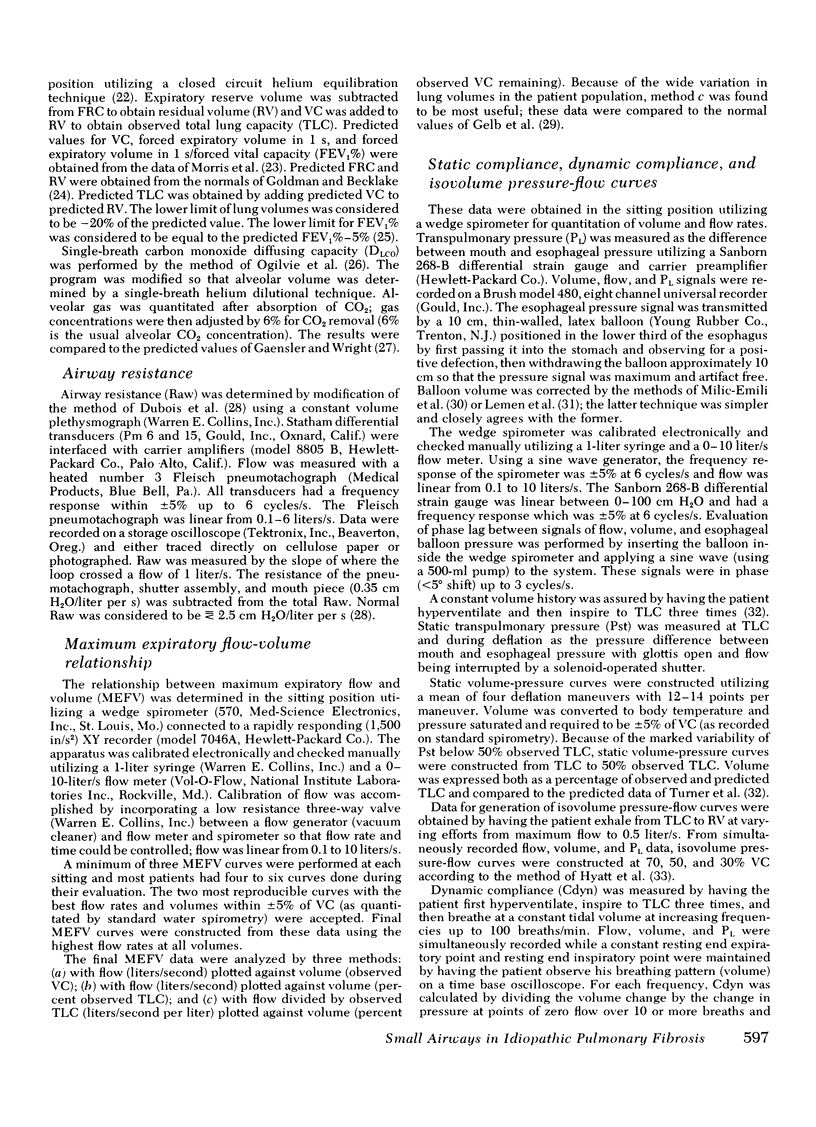
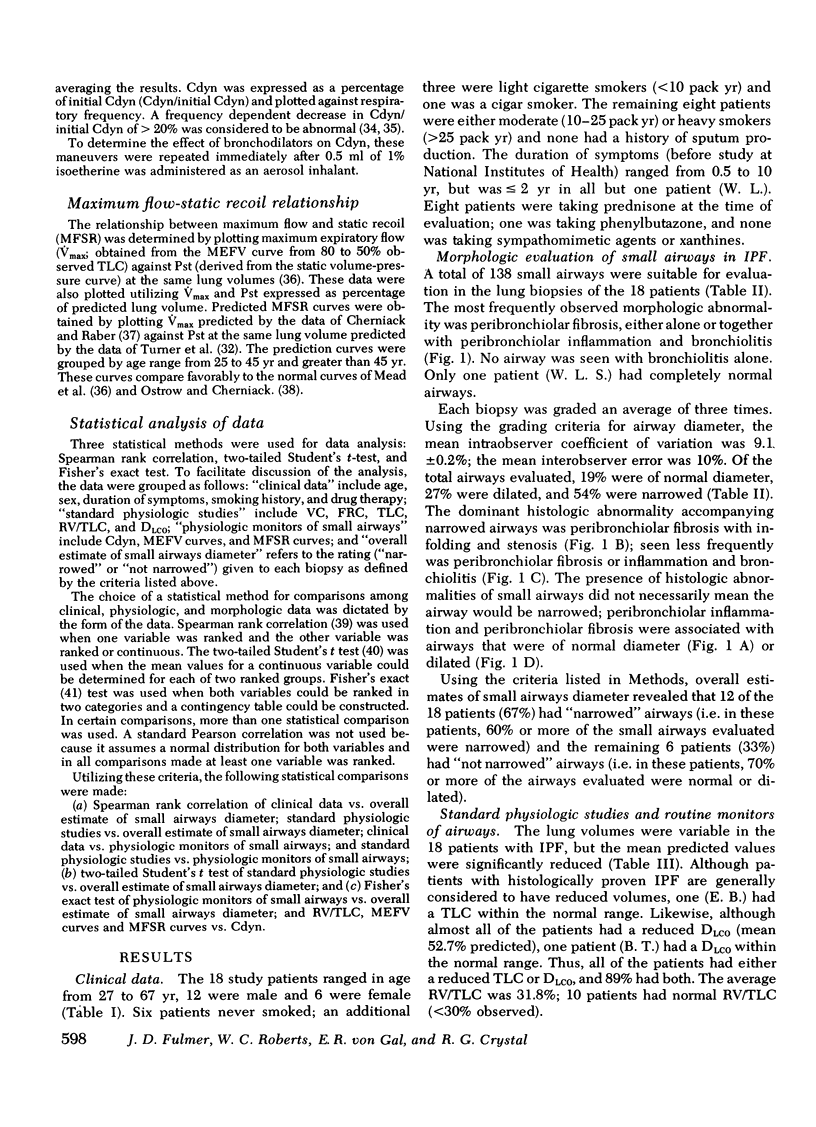
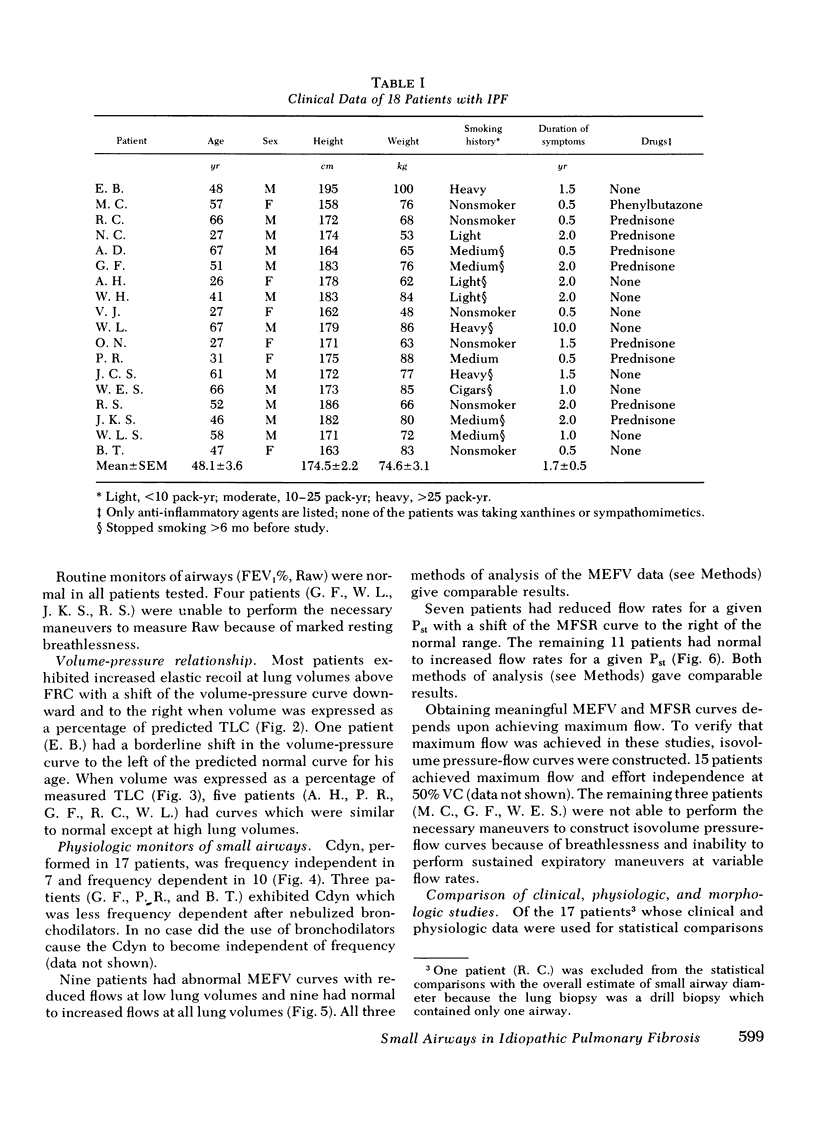

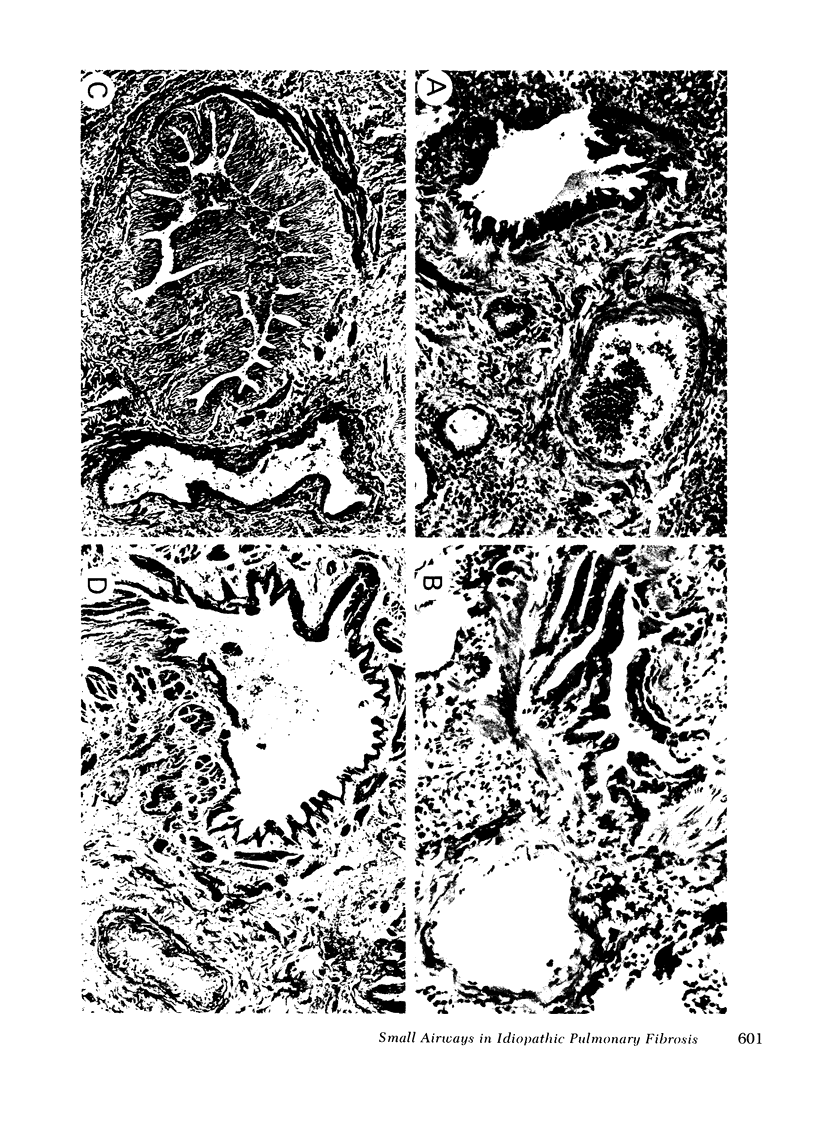
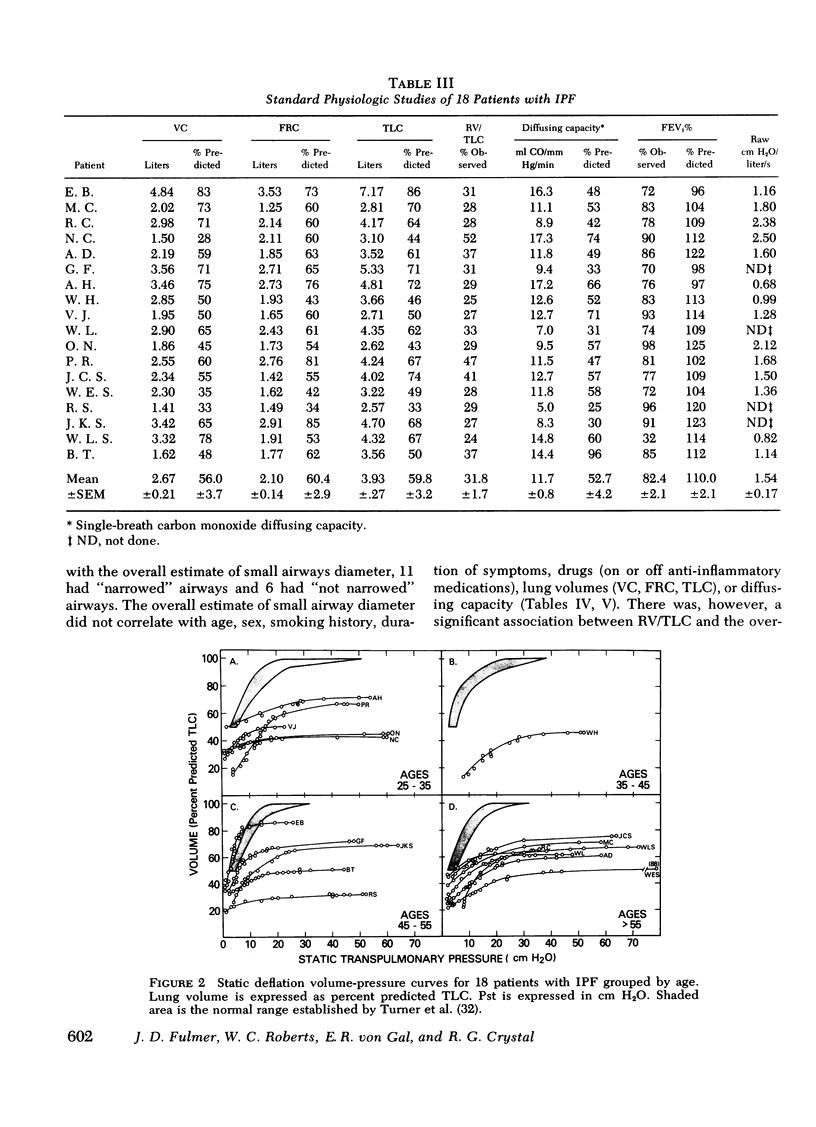
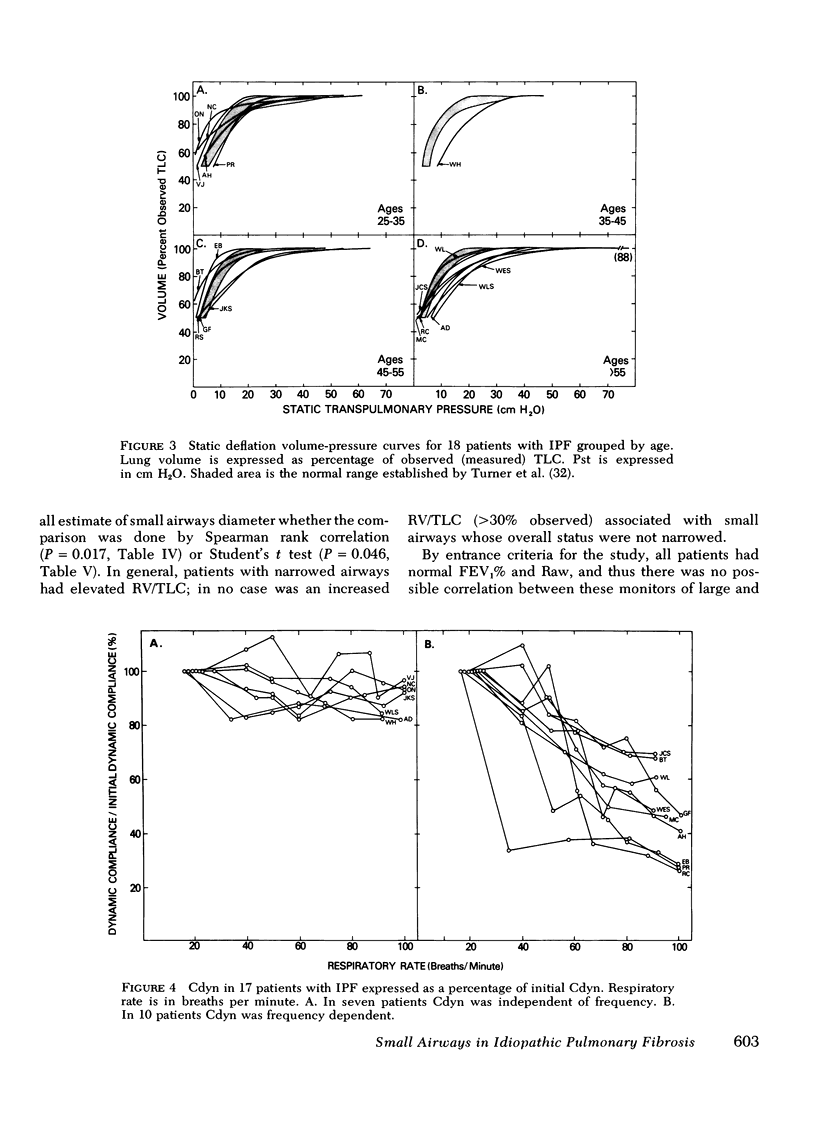
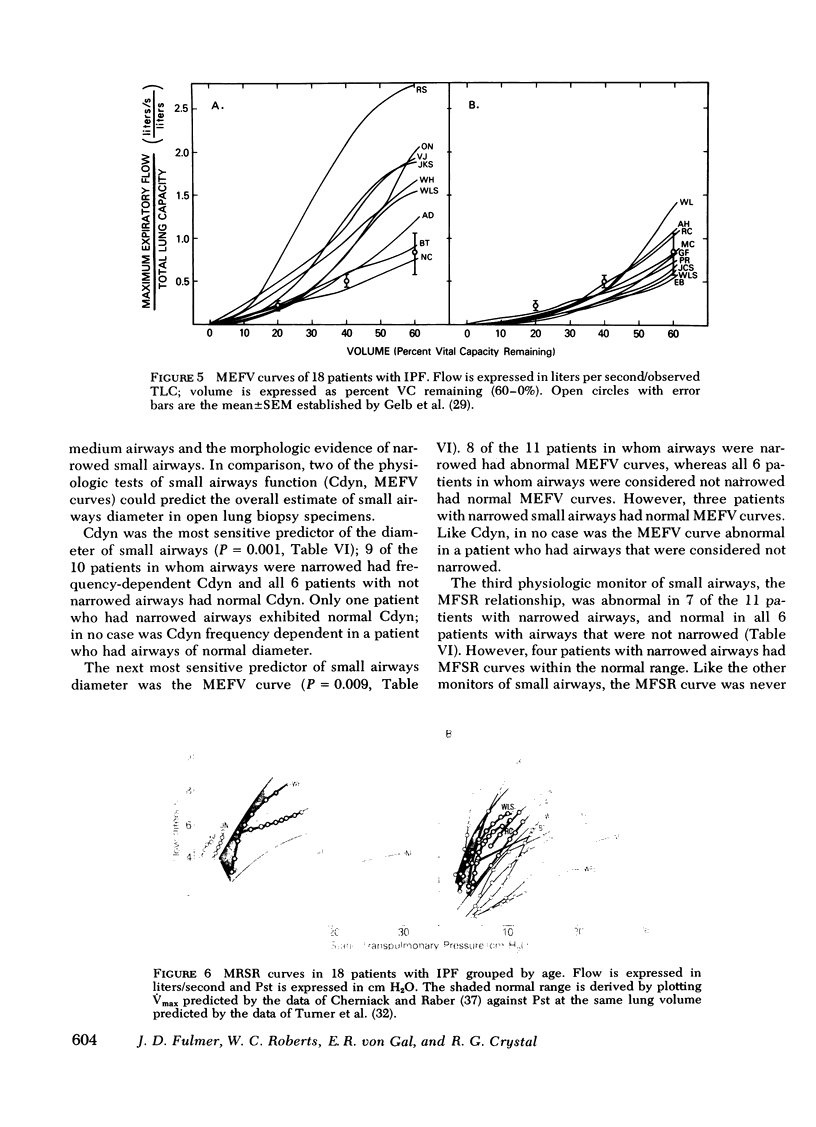

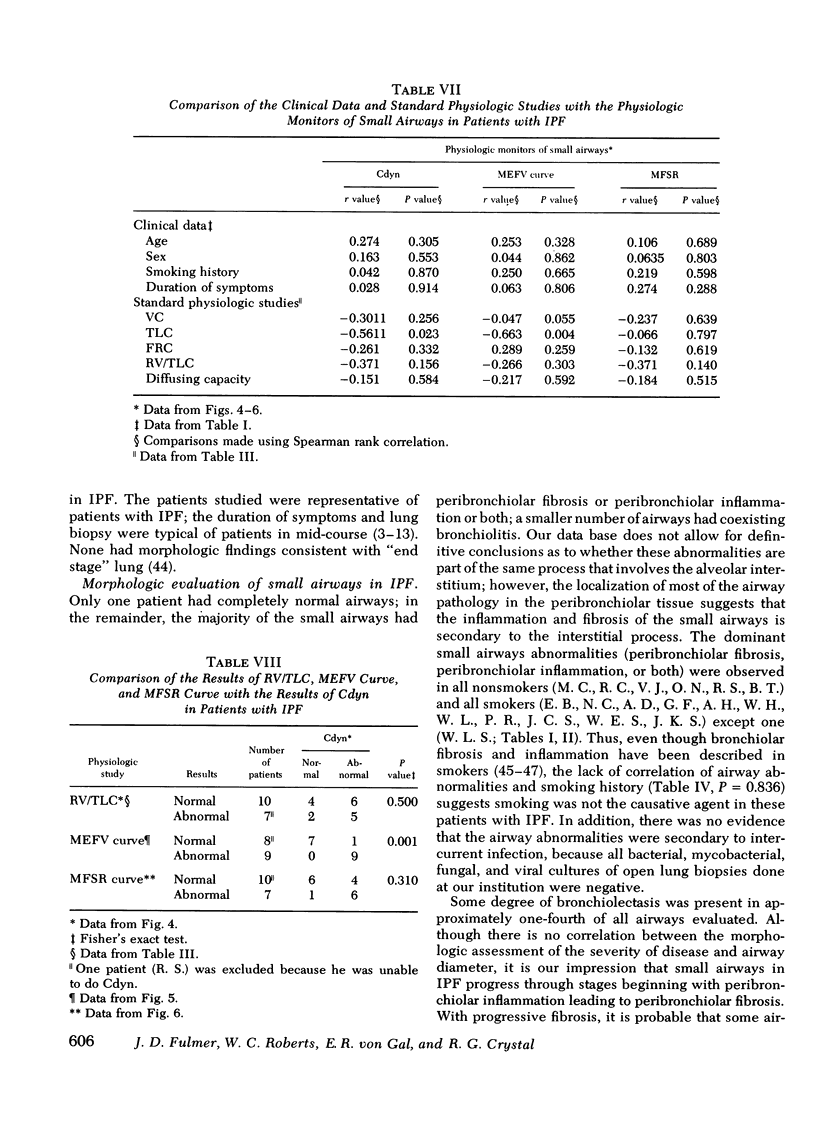
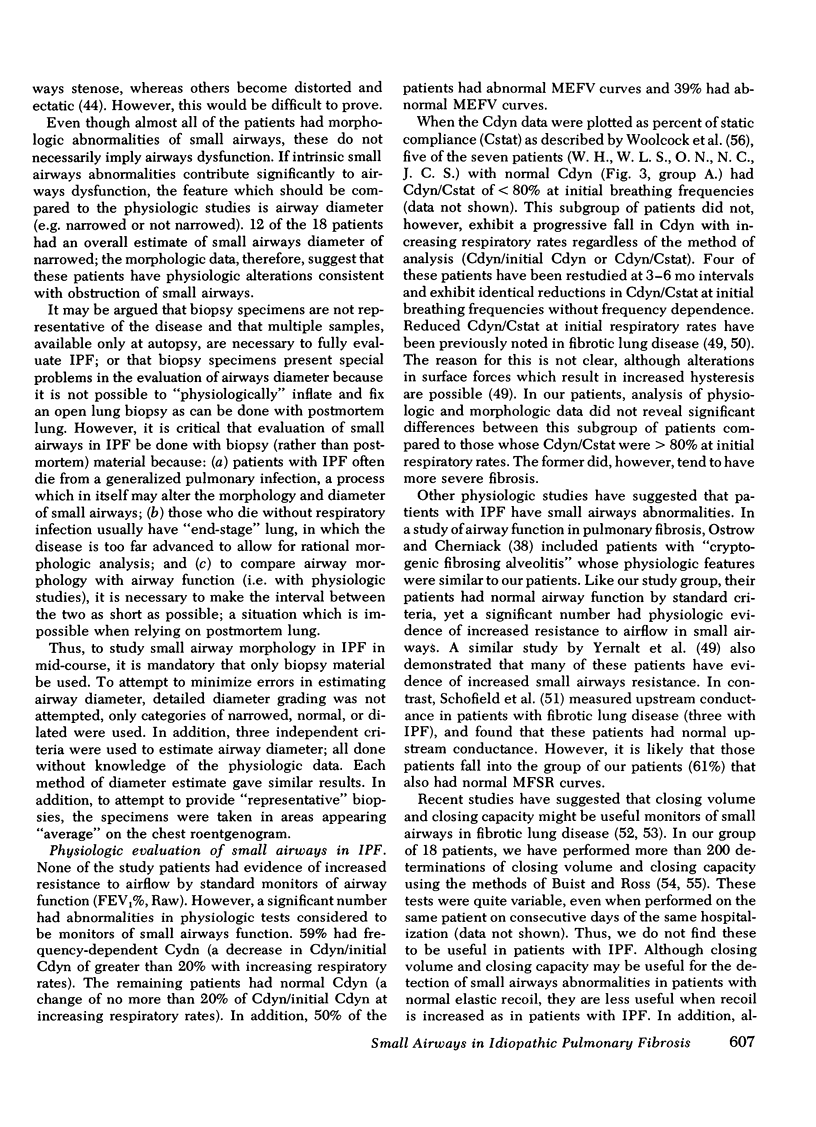
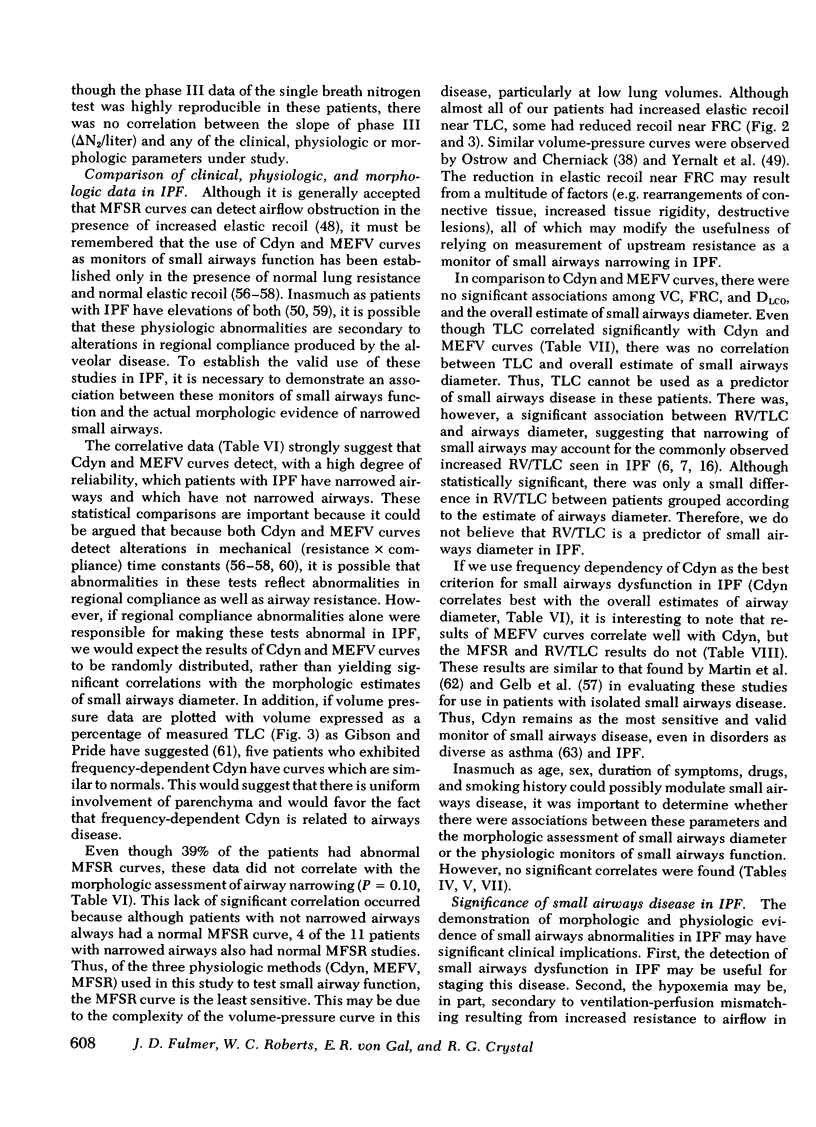
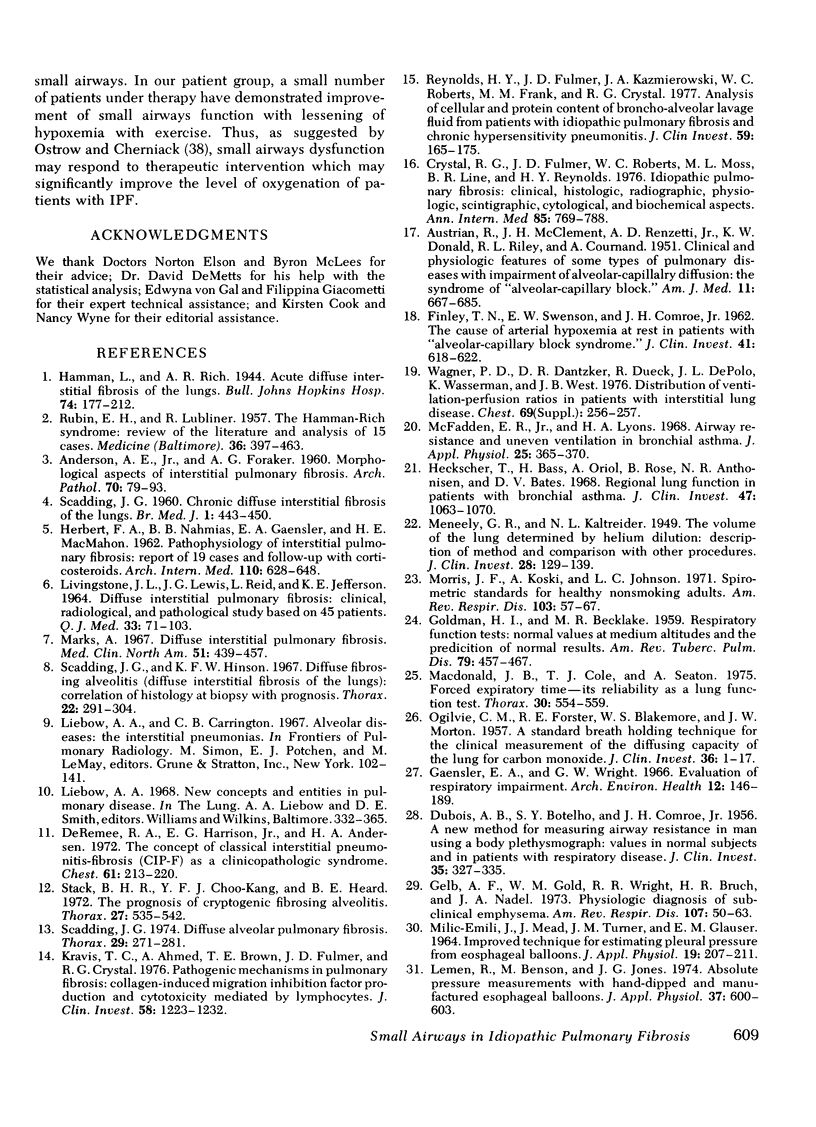
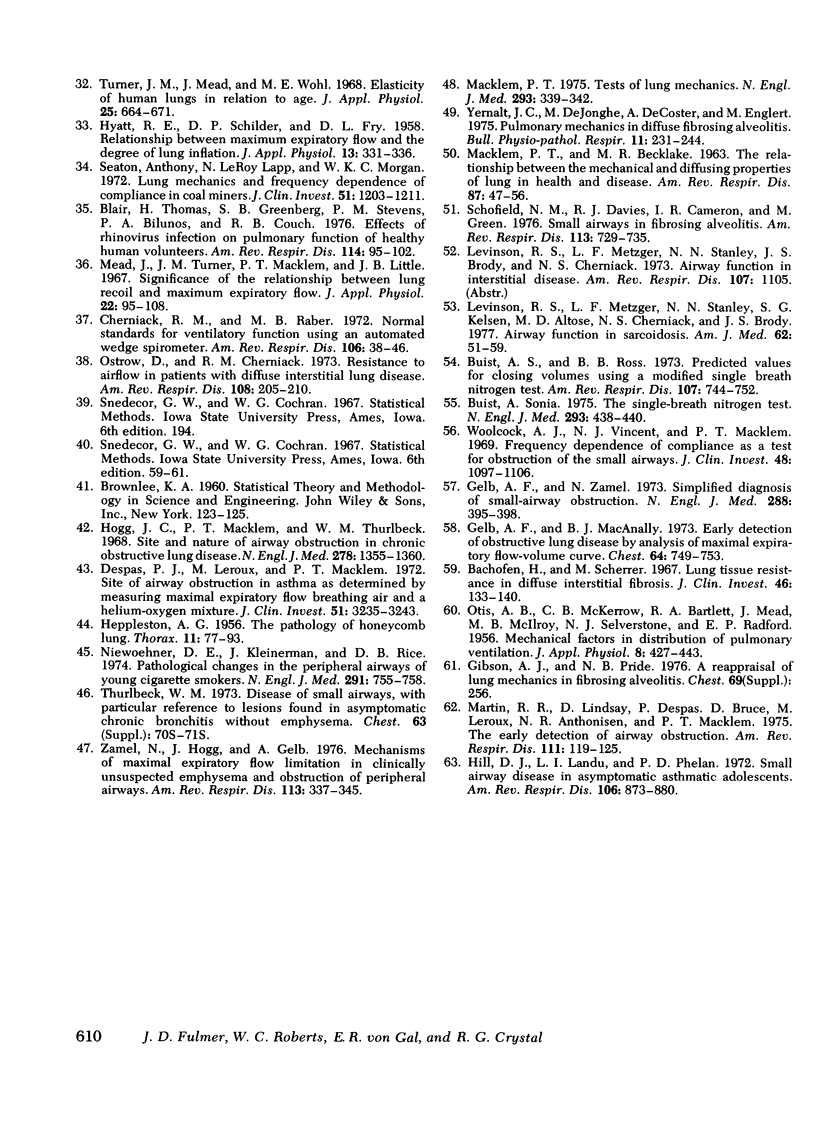
Images in this article
Selected References
These references are in PubMed. This may not be the complete list of references from this article.
- ANDERSON A. E., Jr, FORAKER A. G. Morphological aspects of interstitial pulmonary fibrosis. Arch Pathol. 1960 Jul;70:79–93. [PubMed] [Google Scholar]
- AUSTRIAN R., McCLEMENT J. H., RENZETTI A. D., Jr, DONALD K. W., RILEY R. L., COURNAND A. Clinical and physiologic features of some types of pulmonary diseases with impairment of alveolar-capillary diffusion; the syndrome of "alveolar-capillary block". Am J Med. 1951 Dec;11(6):667–685. doi: 10.1016/0002-9343(51)90019-8. [DOI] [PubMed] [Google Scholar]
- BLAKEMORE W. S., FORSTER R. E., MORTON J. W., OGILVIE C. M. A standardized breath holding technique for the clinical measurement of the diffusing capacity of the lung for carbon monoxide. J Clin Invest. 1957 Jan;36(1 Pt 1):1–17. doi: 10.1172/JCI103402. [DOI] [PMC free article] [PubMed] [Google Scholar]
- Bachofen H., Scherrer M. Lung tissue resistance in diffuse interstitial pulmonary fibrosis. J Clin Invest. 1967 Jan;46(1):133–140. doi: 10.1172/JCI105506. [DOI] [PMC free article] [PubMed] [Google Scholar]
- Blair H. T., Greenberg S. B., Stevens P. M., Bilunos P. A., Couch R. B. Effects of rhinovirus infection of pulmonary function of healthy human volunteers. Am Rev Respir Dis. 1976 Jul;114(1):95–102. doi: 10.1164/arrd.1976.114.1.95. [DOI] [PubMed] [Google Scholar]
- Buist A. S. New tests to assess lung function. The single-breath nitrogen test. N Engl J Med. 1975 Aug 28;293(9):438–440. doi: 10.1056/NEJM197508282930907. [DOI] [PubMed] [Google Scholar]
- Buist A. S., Ross B. B. Predicted values for closing volumes using a modified single breath nitrogen test. Am Rev Respir Dis. 1973 May;107(5):744–752. doi: 10.1164/arrd.1973.107.5.744. [DOI] [PubMed] [Google Scholar]
- Cherniack R. M., Raber M. B. Normal standards for ventilatory function using an automated wedge spirometer. Am Rev Respir Dis. 1972 Jul;106(1):38–46. doi: 10.1164/arrd.1972.106.1.38. [DOI] [PubMed] [Google Scholar]
- Crystal R. G., Fulmer J. D., Roberts W. C., Moss M. L., Line B. R., Reynolds H. Y. Idiopathic pulmonary fibrosis. Clinical, histologic, radiographic, physiologic, scintigraphic, cytologic, and biochemical aspects. Ann Intern Med. 1976 Dec;85(6):769–788. doi: 10.7326/0003-4819-85-6-769. [DOI] [PubMed] [Google Scholar]
- DUBOIS A. B., BOTELHO S. Y., COMROE J. H., Jr A new method for measuring airway resistance in man using a body plethysmograph: values in normal subjects and in patients with respiratory disease. J Clin Invest. 1956 Mar;35(3):327–335. doi: 10.1172/JCI103282. [DOI] [PMC free article] [PubMed] [Google Scholar]
- DeRemee R. A., Harrison E. G., Jr, Andersen H. A. The concept of classic interstitial pneumonitis-fibrosis (CIP-F) as a clinicopathologic syndrome. Chest. 1972 Mar;61(3):213–220. doi: 10.1378/chest.61.3.213. [DOI] [PubMed] [Google Scholar]
- Despas P. J., Leroux M., Macklem P. T. Site of airway obstruction in asthma as determined by measuring maximal expiratory flow breathing air and a helium-oxygen mixture. J Clin Invest. 1972 Dec;51(12):3235–3243. doi: 10.1172/JCI107150. [DOI] [PMC free article] [PubMed] [Google Scholar]
- FINLEY T. N., SWENSON E. W., COMROE J. H., Jr The cause of arterial hypoxemia at rest in patients with "alveolarcapillary block syndrome". J Clin Invest. 1962 Mar;41:618–622. doi: 10.1172/JCI104517. [DOI] [PMC free article] [PubMed] [Google Scholar]
- GOLDMAN H. I., BECKLAKE M. R. Respiratory function tests; normal values at median altitudes and the prediction of normal results. Am Rev Tuberc. 1959 Apr;79(4):457–467. doi: 10.1164/artpd.1959.79.4.457. [DOI] [PubMed] [Google Scholar]
- Gaensler E. A., Wright G. W. Evaluation of respiratory impairment. Arch Environ Health. 1966 Feb;12(2):146–189. doi: 10.1080/00039896.1966.10664355. [DOI] [PubMed] [Google Scholar]
- Gelb A. F., Gold W. M., Wright R. R., Bruch H. R., Nadel J. A. Physiologic diagnosis of subclinical emphysema. Am Rev Respir Dis. 1973 Jan;107(1):50–63. doi: 10.1164/arrd.1973.107.1.50. [DOI] [PubMed] [Google Scholar]
- Gelb A. F., MacAnally B. J. Early detection of obstructive lung disease by analysis of maximal expiratory flow-volume curves. Chest. 1973 Dec;64(6):749–753. doi: 10.1378/chest.64.6.749. [DOI] [PubMed] [Google Scholar]
- Gelb A. F., Zamel N. Simplified diagnosis of small-airway obstruction. N Engl J Med. 1973 Feb 22;288(8):395–398. doi: 10.1056/NEJM197302222880805. [DOI] [PubMed] [Google Scholar]
- Gibson G. J., Pride N. B. A reappraisal of lung mechanics in fibrosing alveolitis. Chest. 1976 Feb;69(2 Suppl):256–256. doi: 10.1378/chest.69.2_supplement.256. [DOI] [PubMed] [Google Scholar]
- HEPPLESTON A. G. The pathology of honeycomb lung. Thorax. 1956 Jun;11(2):77–93. doi: 10.1136/thx.11.2.77. [DOI] [PMC free article] [PubMed] [Google Scholar]
- HERBERT F. A., NAHMIAS B. B., GAENSLER E. A., MACMAHON H. E. Pathophysiology of interstitial pulmonary fibrosis. Report of 19 cases and follow-up with corticosteroids. Arch Intern Med. 1962 Nov;110:628–648. doi: 10.1001/archinte.1962.03620230074012. [DOI] [PubMed] [Google Scholar]
- HYATT R. E., SCHILDER D. P., FRY D. L. Relationship between maximum expiratory flow and degree of lung inflation. J Appl Physiol. 1958 Nov;13(3):331–336. doi: 10.1152/jappl.1958.13.3.331. [DOI] [PubMed] [Google Scholar]
- Heckscher T., Bass H., Oriol A., Rose B., Anthoniesen N. R., Bates D. V. Regional lung function in patients with bronchial asthma. J Clin Invest. 1968 May;47(5):1063–1070. doi: 10.1172/JCI105796. [DOI] [PMC free article] [PubMed] [Google Scholar]
- Hill D. J., Landau L. I., Phelan P. D. Small airway disease in asymptomatic asthmatic adolescents. Am Rev Respir Dis. 1972 Dec;106(6):873–880. doi: 10.1164/arrd.1972.106.6.873. [DOI] [PubMed] [Google Scholar]
- Hogg J. C., Macklem P. T., Thurlbeck W. M. Site and nature of airway obstruction in chronic obstructive lung disease. N Engl J Med. 1968 Jun 20;278(25):1355–1360. doi: 10.1056/NEJM196806202782501. [DOI] [PubMed] [Google Scholar]
- Kravis T. C., Ahmed A., Brown T. E., Fulmer J. D., Crystal R. G. Pathogenic mechanisms in pulmonary fibrosis: collagen-induced migration inhibition factor production and cytotoxicity mediated by lymphocytes. J Clin Invest. 1976 Nov;58(5):1223–1232. doi: 10.1172/JCI108576. [DOI] [PMC free article] [PubMed] [Google Scholar]
- LIVINGSTONE J. L., LEWIS J. G., REID L., JEFFERSON K. E. DIFFUSE INTERSTITIAL PULMONARY FIBROSIS.A CLINICAL, RADIOLOGICAL, AND PATHOLOGICAL STUDY BASED ON 45 PATIENTS. Q J Med. 1964 Jan;33:71–103. [PubMed] [Google Scholar]
- Lemen R., Benson M., Jones J. G. Absolute pressure measurements with hand-dipped and manufactured esophageal balloons. J Appl Physiol. 1974 Oct;37(4):600–603. doi: 10.1152/jappl.1974.37.4.600. [DOI] [PubMed] [Google Scholar]
- Levinson R. S., Metzger L. F., Stanley N. N., Kelsen S. G., Altose M. D., Cherniack N. S., Brody J. S. Airway function in sarcoidosis. Am J Med. 1977 Jan;62(1):51–59. doi: 10.1016/0002-9343(77)90349-7. [DOI] [PubMed] [Google Scholar]
- MILIC-EMILI J., MEAD J., TURNER J. M., GLAUSER E. M. IMPROVED TECHNIQUE FOR ESTIMATING PLEURAL PRESSURE FROM ESOPHAGEAL BALLOONS. J Appl Physiol. 1964 Mar;19:207–211. doi: 10.1152/jappl.1964.19.2.207. [DOI] [PubMed] [Google Scholar]
- Macdonald J. B., Cole T. J., Seaton A. Forced expiratory time--its reliability as a lung function test. Thorax. 1975 Oct;30(5):554–559. doi: 10.1136/thx.30.5.554. [DOI] [PMC free article] [PubMed] [Google Scholar]
- Macklem P. T. New tests to assess lung function. N Engl J Med. 1975 Aug 14;293(7):339–342. doi: 10.1056/NEJM197508142930706. [DOI] [PubMed] [Google Scholar]
- Marks A. Diffuse interstitial pulmonary fibrosis. Med Clin North Am. 1967 Mar;51(2):439–457. doi: 10.1016/s0025-7125(16)33067-x. [DOI] [PubMed] [Google Scholar]
- Martin R. R., Lindsay D., Despas P., Bruce D., Leroux M., Anthonisen N. R., Macklem P. T. The early detection of airway obstruction. Am Rev Respir Dis. 1975 Feb;111(2):119–125. doi: 10.1164/arrd.1975.111.2.119. [DOI] [PubMed] [Google Scholar]
- Mead J., Turner J. M., Macklem P. T., Little J. B. Significance of the relationship between lung recoil and maximum expiratory flow. J Appl Physiol. 1967 Jan;22(1):95–108. doi: 10.1152/jappl.1967.22.1.95. [DOI] [PubMed] [Google Scholar]
- Meneely G. R., Kaltreider N. L. THE VOLUME OF THE LUNG DETERMINED BY HELIUM DILUTION. DESCRIPTION OF THE METHOD AND COMPARISON WITH OTHER PROCEDURES. J Clin Invest. 1949 Jan;28(1):129–139. doi: 10.1172/JCI102041. [DOI] [PMC free article] [PubMed] [Google Scholar]
- Morris J. F., Koski A., Johnson L. C. Spirometric standards for healthy nonsmoking adults. Am Rev Respir Dis. 1971 Jan;103(1):57–67. doi: 10.1164/arrd.1971.103.1.57. [DOI] [PubMed] [Google Scholar]
- Niewoehner D. E., Kleinerman J., Rice D. B. Pathologic changes in the peripheral airways of young cigarette smokers. N Engl J Med. 1974 Oct 10;291(15):755–758. doi: 10.1056/NEJM197410102911503. [DOI] [PubMed] [Google Scholar]
- OTIS A. B., MCKERROW C. B., BARTLETT R. A., MEAD J., MCILROY M. B., SELVER-STONE N. J., RADFORD E. P., Jr Mechanical factors in distribution of pulmonary ventilation. J Appl Physiol. 1956 Jan;8(4):427–443. doi: 10.1152/jappl.1956.8.4.427. [DOI] [PubMed] [Google Scholar]
- Ostrow D., Cherniack R. M. Resistance to airflow in patients with diffuse interstitial lung disease. Am Rev Respir Dis. 1973 Aug;108(2):205–210. doi: 10.1164/arrd.1973.108.2.205. [DOI] [PubMed] [Google Scholar]
- RUBIN E. H., LUBLINER R. The Hamman-Rich syndrome: review of the literature and analysis of 15 cases. Medicine (Baltimore) 1957 Dec;36(4):397–463. doi: 10.1097/00005792-195712000-00001. [DOI] [PubMed] [Google Scholar]
- Reynolds H. Y., Fulmer J. D., Kazmierowski J. A., Roberts W. C., Frank M. M., Crystal R. G. Analysis of cellular and protein content of broncho-alveolar lavage fluid from patients with idiopathic pulmonary fibrosis and chronic hypersensitivity pneumonitis. J Clin Invest. 1977 Jan;59(1):165–175. doi: 10.1172/JCI108615. [DOI] [PMC free article] [PubMed] [Google Scholar]
- SCADDING J. G. Chronic diffuse interstitial fibrosis of the lungs. Br Med J. 1960 Feb 13;1(5171):443–450. doi: 10.1136/bmj.1.5171.443. [DOI] [PMC free article] [PubMed] [Google Scholar]
- Scadding J. G. Diffuse pulmonary alveolar fibrosis. Thorax. 1974 May;29(3):271–281. doi: 10.1136/thx.29.3.271. [DOI] [PMC free article] [PubMed] [Google Scholar]
- Scadding J. G., Hinson K. F. Diffuse fibrosing alveolitis (diffuse interstitial fibrosis of the lungs). Correlation of histology at biopsy with prognosis. Thorax. 1967 Jul;22(4):291–304. doi: 10.1136/thx.22.4.291. [DOI] [PMC free article] [PubMed] [Google Scholar]
- Schofield N. C., Davies R. J., Cameron I. R., Green M. Small airways in fibrosing alveolitis. Am Rev Respir Dis. 1976 Jun;113(6):729–735. doi: 10.1164/arrd.1976.113.6.729. [DOI] [PubMed] [Google Scholar]
- Seaton A., Lapp N. L., Morgan W. K. Lung mechanics and frequency dependence of compliance in coal miners. J Clin Invest. 1972 May;51(5):1203–1211. doi: 10.1172/JCI106914. [DOI] [PMC free article] [PubMed] [Google Scholar]
- Stack B. H., Choo-Kang Y. F., Heard B. E. The prognosis of cryptogenic fibrosing alveolitis. Thorax. 1972 Sep;27(5):535–542. doi: 10.1136/thx.27.5.535. [DOI] [PMC free article] [PubMed] [Google Scholar]
- Thurlbeck W. M. Disease of small airways, with particular reference to lesions found in asymptomatic chronic bronchitis without emphysema. Chest. 1973 Apr;63(Suppl):70S–71S. doi: 10.1378/chest.63.4_supplement.70s. [DOI] [PubMed] [Google Scholar]
- Turner J. M., Mead J., Wohl M. E. Elasticity of human lungs in relation to age. J Appl Physiol. 1968 Dec;25(6):664–671. doi: 10.1152/jappl.1968.25.6.664. [DOI] [PubMed] [Google Scholar]
- Wagner P. D., Dantzker D. R., Dueck R., de Polo J. L., Wasserman K., West J. B. Distribution of ventilation-perfusion ratios in patients with interstitial lung disease. Chest. 1976 Feb;69(2 Suppl):256–257. doi: 10.1378/chest.69.2_supplement.256-a. [DOI] [PubMed] [Google Scholar]
- Woolcock A. J., Vincent N. J., Macklem P. T. Frequency dependence of compliance as a test for obstruction in the small airways. J Clin Invest. 1969 Jun;48(6):1097–1106. doi: 10.1172/JCI106066. [DOI] [PMC free article] [PubMed] [Google Scholar]
- Yernault J. C., de Jonghe M., de Coster A., Englert M. Pulmonary mechanics in diffuse fibrosing alveolitis. Bull Physiopathol Respir (Nancy) 1975 Mar-Apr;11(2):231–244. [PubMed] [Google Scholar]
- Zamel N., Hogg J., Gelb A. Mechanisms of maximal expiratory flow limitation in clinically unsuspected emphysema and obstruction of the peripheral airways. Am Rev Respir Dis. 1976 Mar;113(3):337–345. doi: 10.1164/arrd.1976.113.3.337. [DOI] [PubMed] [Google Scholar]



